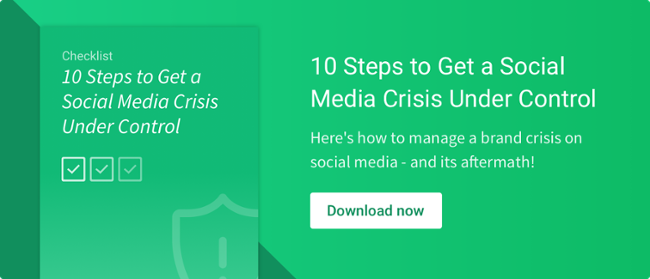Nobody wants to deal with crises. They’re not fun. Most of us just avoid thinking about them.
Like paying taxes, it’s always better to be prepared for a crisis before it’s too late. But unlike taxes, crises don’t happen at a given time of the year. They attack whenever they want. So you have to be always on guard.
Luckily, there are tools that’ll help. And it’s best you learn how to use them now, work them into your processes so when you need them, they’re ready to go.
In this blog post, you’ll find the five tools you need to get you through a social media crisis, along with a foolproof, step-by-step process to manage and survive a brand disaster.
5 tools to help you get through a social media disaster
Wanna save a list of these tools just in case? Download the pdf for free!
1. Your smartphone – stay connected on the go
Social media is always on – and in a crisis, you need to be, too. You need to stay connected. At all times.
Your smartphone is where you’ll check in on existing conversations, watch for developments, and keep the rest of your team informed. Make sure it’s always charged, on, and connected to a stable WiFi network.
2. Mention – monitor all conversations
The best time to deal with a marketing or PR crisis is before anyone else knows about it. Of course, that’s unlikely, especially when it involves social media.
To manage social platforms, forums, and news sites, you need more than your regular social media notifications.
You need something that monitors social media mentions, as well as keywords and hashtags anywhere online. You need a full monitoring tool like Mention.
With Mention, you receive alerts for all conversations about your brand in real-time, so you’ll never miss a thing. You can also filter mentions by influence and prioritize replies to VIPs who have bigger social followings.
3. Buffer – manage publishing
How you communicate during and post-crisis can determine the damage done to your brand. A social media management tool like Buffer comes in handy in times like this.
You’ll want to be able to:
- Press “pause” on any social marketing campaigns and fun posts to keep the focus on communicating updates.
- Schedule posts for specific times, such as when you’re going to be releasing a formal update.
- Spread posts linking to new information or updates for people who didn’t see it the first time.
Buffer supports all of this and is our marketing team’s favorite scheduler as it’s super easy to use.
4. Slack – communicate with your team
In a fast-moving online crisis, you need a communication tool that can keep up with the speed. You don’t need more headaches finding email threads among newsletters and other distracting correspondence.
Slack– a real-time communication app for teams – is built just for this. You can switch from direct one-on-one messages to group messages seamlessly, create a special channel dedicated to managing the crisis, and attach images, tweets, and media files easily. Push notifications also make it impossible to miss direct messages or @mentions.
5. Canned Responses – deal with email in bulk
As soon as you’ve identified the crisis, you’ll need to start updating your customers, colleagues, the press, and other key stakeholders.
Annoyingly, most people are going to ask you the same questions. But that’s great news if you’re replying in bulk.
Use Gmail’s Canned Responses or a similar template tool to save time writing the same information out over and over. You can template large chunks of text to easily reuse in multiple emails. You can also create more than a few responses for different stakeholder types.
Now that you’ve got the tools, you still need a process. And we’re not gonna leave you hanging. Here’s our very own, tried and tested process for tough times like these:
Step-by-step process to handle a social media crisis
Your team needs a solid crisis management strategy so that if you get hit, you can create a game plan and spring into action ASAP. Here’s how:
1. Define what constitutes a crisis
There’s a big difference between a negative event and a full-on disaster. Your crisis team doesn’t need to be “called in” every time there’s an angry tweet. Define the scenarios you will use this plan for, and which ones you’ll handle normally.
There are three characteristics of a true social media crisis. If these three happen, you’re in crisis mode.
- When you don’t know any more than the public about what’s going on. When one of your shops caught fire and you found out about it on Twitter – that’s the first sign of a social media crisis.
- When there’s a change from the norm. Apple is often criticized for their questionable labor practices in China. That’s ongoing and expected, so it doesn’t constitute a crisis. When a discussion about how their phones snap and bend after a release goes viral – that’s a whole different matter.
- When the issue at hand has a significant impact on your brand’s reputation. Someone tweeting that their double cheese whopper at Burger King is missing a slice of cheese isn’t a crisis. A shooting at a Burger King is.
2. Find ways to spot crises
To control a crisis, you need to know when it breaks out.
Set guidelines for how your team will find them. These should include:
- What tool(s) you’ll use to monitor brand crises
- Who’s responsible for managing the tool
- Your ongoing process for crisis monitoring
Get these clear now, so that you’re ready if the worst should happen.
3. Assign clear roles
Make sure everyone knows what they’re supposed to be doing – except freaking out – in a crisis. Determine everyone’s roles before anything bad happens.
You may have one person doing everything, a different team member for each task, or land somewhere in between. Be it the decision-maker, peacemaker, or PR ambassador, make sure roles are set and crystal clear.
4. Prioritize goals and efforts
Unfortunately, you won’t be able to erase a crisis overnight, as damage control takes time.
You also won’t be able to answer every unhappy customer if your social media crisis was widespread.
Decide what goals are most important and immediate and which are longer-term. What is the most important outcome of your crisis management? Who are the people you must respond to first?
5. Create guidelines
You may have several people answering questions and complaints on multiple platforms. You want to make sure your message is consistent. Before anyone writes a response in the moment, they should know what guidelines to follow.
Content and format will be different for each social media channel, and you’ll also speak differently to key stakeholders versus the general public. Set specific guidelines for each communication channel and type.
This is especially important if you’ll ask for help from employees outside of the crisis communications team.
6. Reflect and evaluate
After the crisis blows over, it’s important to determine the impact it’s had on your brand.
What’s the impact of this crisis on overall brand sentiment? What has to be done in the long run to fix the damages? Which key areas do you need to rebuild trust with your customers or stakeholders?
You also want to look at how well you managed the crisis and how processes can be improved. What were the unanticipated problems and how can you modify the crisis plan to improve future crisis management?
These debriefings after a crisis can help speed up recovery, prevent further issues, and improve future crisis management.
Be prepared

You can’t avoid brand crises. But you can prepare yourself before one happens. Get your team ready in advance. Pick out tools. Learn how to use them. Set and document processes.
Sometimes, a brand crisis can even be a great PR opportunity in disguise.






